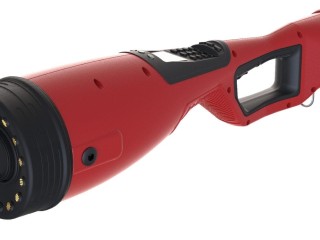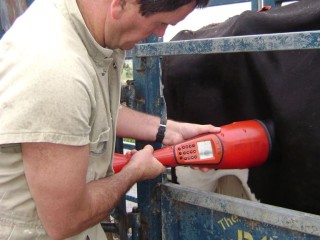 The beef industry has long recognised the need for a method of fast, accurate crush-side pregnancy detection, which can be performed by laymen, rather than vets or others with specialist palpation or ultrasound scanning skills.
The beef industry has long recognised the need for a method of fast, accurate crush-side pregnancy detection, which can be performed by laymen, rather than vets or others with specialist palpation or ultrasound scanning skills.
Now that dream is rapidly approaching reality, with a series of commercial trials and final software development bringing a four-year project to a conclusion which could soon deliver such a technology.
Technology company, Heard Systems is developing a hand-held, easy-to-operate and non-invasive pregnancy testing device called the ePreg, which is now reaching an important pre-launch phase.
Perhaps the biggest attraction with the equipment is that unlike current preg testing methods of rectal palpation and ultrasound scanning – which both require specialised and highly-refined skills – ePreg can be used by any individual with minimal training.
Beef producers across Australia can now contribute to ePreg’s commercialisation process by participating in an on-line survey that will deliver important market performance expectation signals to the developers (see details at bottom of story).
Using audio signals, the ePreg device, pictured here, detects the heartbeat of a foetus when the head is pressed against a cow’s flank. Unlike the other methods of pregnancy detection, it is non-invasive and causes minimal stress or risk of injury to either the animal or the operator. The complete unit weighs only 2.75kg.
While figures on rectal palpation testing accuracy are difficult to find, it is certainly variable from operator to operator. One stakeholder with specific knowledge in the area told Beef Central that a good vet or practitioner should get 95pc of calls on pregnancy using palpation, with empties being harder.
One of the challenges in many areas, however, is the lack of availability of competent contractors/vets, and another is the difficulty in scheduling visits to match mustering timeframes. In plenty of cases, preg testing is simply overlooked as being ‘too hard’ for these logistical reasons.
However, by moving the detection role into the hands of the layman using an ePreg, many of these challenges disappear.
Improving reproductive performance
Good reproductive performance is a key goal for all cattlemen, and pregnancy testing is the most cost effective tool available to the industry to manage herd fertility. Despite this, an MLA survey found that less than half of all beef cattle producers currently preg test on an annual basis.
The ePreg has the potential to enable producers to improve the reproductive management of their herd by making preg testing easy to do themselves, and eliminating the need to plan around the availability of a vet or contractor.
Significant funding support for the development of the device has come from the Meat & Livestock Australia Donor Company, which recently committed further funds.
In one project report, MLA estimated that the device could deliver productivity improvements worth more than $100 million each year to the northern beef industry alone.
Progress on development of the ePreg is occurring on a number of levels, with the physical development of the hardware now well-advanced.
Conscious of the tough crush-side working environment, Heard Systems has come up with an apparatus which is robust, dust-proof and shockproof. The moulded body is the same material as used in military rifle stocks.
“Some of the testing work so far has been in races, rather than crushes, and on occasion the units have been wedged by a beast against a hardwood or railway iron post, without problems,” said Heard Systems chief executive Jeremy Cocks.
“It’s extremely important that the internals are well protected, because of the sophisticated computer and electronic components inside,” he said.
The main software development focus is now on the refinement of algorithms used to remove background noises in an animal when searching for and monitoring the foetal heartbeat.
Two separate algorithms for screening-out unwanted noise are currently being fused, which developers are confident will deliver a product with detection accuracies high enough to take a commercial product to market early next year.
“We’re not quite there yet, but we are making some very significant progress,” Mr Cocks said.
“This is not an easy thing to do, because there is a lot of background noise going on inside a beast, including the digestion process, the mother's own heartbeat and breathing, and the electro-static noise from placing electrodes on the beast’s hide,” he said.
 Currently Heard Systems is working to meet one of its key MLA development milestones, which is to collect 2000 records from animals of known pregnancy status, across a range of breeds, regions and environments. That process is half complete, with the testing team moving into extensive herds in Central Queensland next week after completing earlier work in southern Australia.
Currently Heard Systems is working to meet one of its key MLA development milestones, which is to collect 2000 records from animals of known pregnancy status, across a range of breeds, regions and environments. That process is half complete, with the testing team moving into extensive herds in Central Queensland next week after completing earlier work in southern Australia.
Once the current data collection is completed, Heard Systems is keen to sell a limited number of pilot units (perhaps ten units, into different geographic and herd applications), as the precursor to a full commercial release in 2012.
Subject to the results from the pilot unit trials and the current software refinements, Heard will begin building the units on a larger scale, which could lead to commercial release in the second quarter next year.
Several levels of detection performance could emerge. In the first instance it may be as simple as making a pregnant/non pregnant call on a beast, with a required degree of accuracy.
“We think we need a product that can detect with well above 90pc accuracy, in anybody’s hands, and in some segments of the market, 95pc may be required,” Mr Cocks said.
“But that is one of the reasons we are keen to get as much traffic to our online survey as possible – so we can actually gauge industry expectations in terms of speed and accuracy.”
In herds that are currently not monitored for pregnancy status at all, obviously a modest level of testing performance would still be attractive, but there will be other herds where very high levels of accuracy will be required.
A second stage of development will include ageing of the foetus, certainly by tri-mester, and eventually by month-of-age. This will be achieved by picking up subtle variations in both heartbeat rate and volume as the foetus grows.
Speed of testing of the current prototype units in the hands of a capable operator is currently around one minute per beast, but that will inevitably reduce as the current software refinements are completed. Heard Systems is aiming for an end product with speed approaching that of a skilled vet preg-tester using palpation.
But the big advantage, of course, is the unit is ready to operate on a moment’s notice, with no need for prior planning or preparation for a vet visit.
Producers’ survey participation can help
To help understand the pregnancy testing needs of cattle producers, Heard Systems has established an on-line producer survey on its website.
The survey takes only a few minutes to complete, and as an incentive, Heard is offering a free gift in the form of a quality pocketknife (while stocks last) to participants.
Questions include how much producers currently pay for vet-based preg-testing, how they currently test and how often, and what their expectations are for testing accuracy.
The responses will provide valuable signals about what levels of performance are required to be built into ePreg equipment to meet different industry requirements.
To participate in the survey, click here
